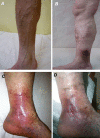Serum iron concentration and plasma oxidant-antioxidant balance in patients with chronic venous insufficency
- PMID: 22129904
- PMCID: PMC3628123
- DOI: 10.12659/msm.882132
Serum iron concentration and plasma oxidant-antioxidant balance in patients with chronic venous insufficency
Abstract
Background: The aim of this study was to evaluate serum iron concentration and influence of this element on biomarkers of oxidative stress in patients affected by chronic venous insufficiency (CVI).
Material/methods: Serum iron (SI) concentration and plasma parameters of oxidant-antioxidant balance (i.e., malonyldialdehyde [MDA], uric acid [UA] concentration, and total antioxidant capacity [TAC]) were compared between 35 patients divided into appropriate groups and 23 healthy individuals.
Results: The subgroups analysis showed that SI concentration was significantly higher only in patients with shorter duration of CVI in comparison with the control group (P = 0.013). Significant, negative correlation was found between SI concentration and duration of the disease (r = -0.422, P = 0.014), age of the patients (r = -0.542, P = 0.001) and BMI (r = -0.408, P = 0.018). Mean value of MDA concentration and TAC capacity were higher in patients with CVI in comparison with healthy individuals (P < 0.05). UA concentration was decreased, especially in CVI patients with mild clinical stage of disease and shorter CVI duration (P = 0.047; P = 0.034). There was no significant correlation found between SI concentration and the parameters of oxidant-antioxidant balance.
Conclusions: High concentration of MDA and low UA level in blood of CVI patients suggests that oxidative stress plays an important role in the pathogenesis of the disease. The increase in SI concentration observed in the early stage of CVI can enhance free radicals formation; however, direct evidence has not been provided by the present study.
Figures





Similar articles
-
Plasma concentration of selected biochemical markers of endothelial dysfunction in women with various severity of chronic venous insufficiency (CVI)-A pilot study.PLoS One. 2018 Jan 29;13(1):e0191902. doi: 10.1371/journal.pone.0191902. eCollection 2018. PLoS One. 2018. PMID: 29377939 Free PMC article.
-
A plasma oxidative stress global index in early stages of chronic venous insufficiency.J Vasc Surg. 2013 Jan;57(1):205-13. doi: 10.1016/j.jvs.2012.05.085. Epub 2012 Nov 20. J Vasc Surg. 2013. PMID: 23182154
-
The association of oxidant status and antioxidant capacity in children with acute and chronic ITP.J Pediatr Hematol Oncol. 2010 May;32(4):277-81. doi: 10.1097/MPH.0b013e3181d6421f. J Pediatr Hematol Oncol. 2010. PMID: 20404751
-
Comparison of Oxidative Stress Parameters in Heart Failure Patients Depending on Ischaemic or Nonischaemic Aetiology.Oxid Med Cell Longev. 2019 Sep 17;2019:7156038. doi: 10.1155/2019/7156038. eCollection 2019. Oxid Med Cell Longev. 2019. PMID: 31636808 Free PMC article.
-
The effect of daily consumption of probiotic and conventional yoghurt on oxidant and anti-oxidant parameters in plasma of young healthy women.Int J Vitam Nutr Res. 2007 Mar;77(2):79-88. doi: 10.1024/0300-9831.77.2.79. Int J Vitam Nutr Res. 2007. PMID: 17896581
Cited by
-
Molecular Determinants of Chronic Venous Disease: A Comprehensive Review.Int J Mol Sci. 2023 Jan 18;24(3):1928. doi: 10.3390/ijms24031928. Int J Mol Sci. 2023. PMID: 36768250 Free PMC article. Review.
-
Plasma concentration of selected biochemical markers of endothelial dysfunction in women with various severity of chronic venous insufficiency (CVI)-A pilot study.PLoS One. 2018 Jan 29;13(1):e0191902. doi: 10.1371/journal.pone.0191902. eCollection 2018. PLoS One. 2018. PMID: 29377939 Free PMC article.
-
HFE p.C282Y gene variant is associated with varicose veins in Russian population.Clin Exp Med. 2016 Aug;16(3):463-70. doi: 10.1007/s10238-015-0377-y. Epub 2015 Sep 28. Clin Exp Med. 2016. PMID: 26416403
-
Prophylactic treatment with transdermal deferoxamine mitigates radiation-induced skin fibrosis.Sci Rep. 2020 Jul 23;10(1):12346. doi: 10.1038/s41598-020-69293-4. Sci Rep. 2020. Retraction in: Sci Rep. 2025 May 12;15(1):16410. doi: 10.1038/s41598-025-00263-4. PMID: 32704071 Free PMC article. Retracted.
-
Evaluation of the dynamic thiol/disulfide homeostasis in patients with chronic venous insufficiency.J Vasc Surg Venous Lymphat Disord. 2024 Jan;12(1):101689. doi: 10.1016/j.jvsv.2023.09.003. Epub 2023 Oct 1. J Vasc Surg Venous Lymphat Disord. 2024. PMID: 37788743 Free PMC article.
References
-
- Elsharawy MA, Naim MM, Abdelmaguid EM, Al-Mulhim AA. Role of saphenous vein wall in the pathogenesis of primary varicose veins. Interact Cardiovasc Thorac Surg. 2007;6:219–24. - PubMed
-
- Saharay M, Shields DA, Georgiannos SN, et al. Endothelial activation in patients with chronic venous disease. Eur J Vasc Surg. 1998;15:342–49. - PubMed
-
- Cesarone MR, Belcaro GB, Pellegrini L, et al. Circulating endothelial cells in venous blood as a marker of endothelial damage in chronic venous insufficiency: improvement with Venoruton. J Cardiovasc Pharmacol Therapeut. 2006;11:93–98. - PubMed
-
- Walia M, Kwan CY, Grover AK. Effects of free radicals on coronary artery. Med Princ Pract. 2003;12:1–9. - PubMed
-
- Berry C, Brosnan MJ, Fennell J, et al. Oxidative stress and vascular damage in hypertension. Curr Opin Nephrol Hypertens. 2001;10:247–55. - PubMed
Publication types
MeSH terms
Substances
LinkOut - more resources
Full Text Sources
Medical

